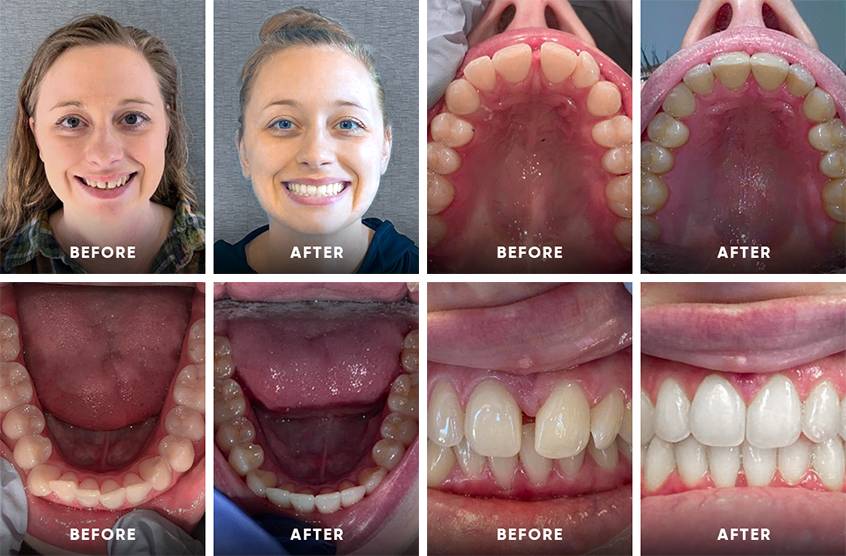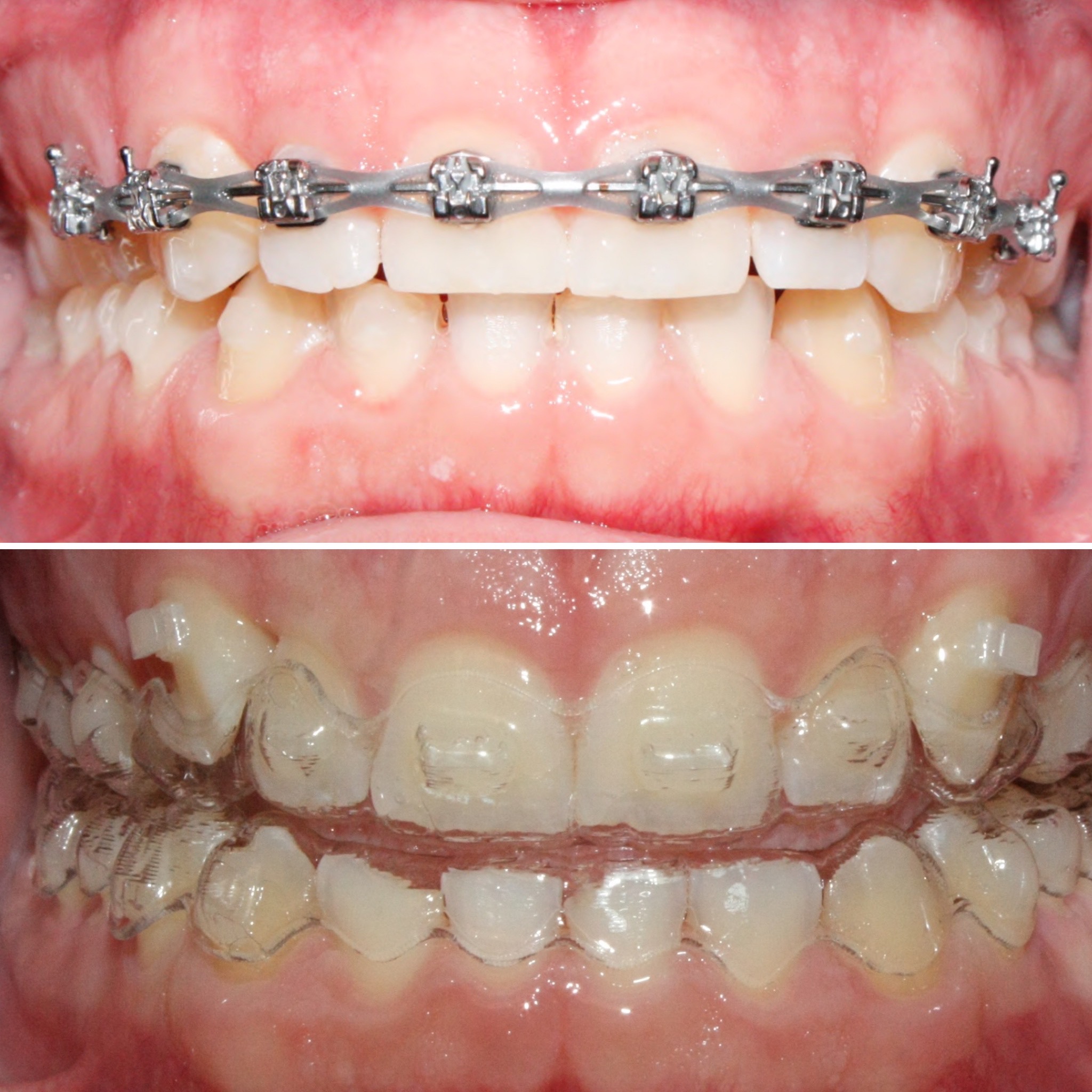The Ultimate Comparison: Invisalign vs. Traditional Braces for Adults
The Ultimate Comparison: Invisalign vs. Traditional Braces for Adults
Blog Article
Invisalign vs. Typical Braces: Which Option Is Right for You?
When thinking about orthodontic therapy, the selection in between Invisalign and conventional braces provides numerous vital factors that merit cautious examination. Invisalign uses a very discreet choice with removable aligners, while conventional braces supply a much more noticeable yet efficient remedy for extreme imbalance. Each alternative incorporates distinctive advantages and downsides associated with aesthetic appeals, convenience, therapy period, and expense. Comprehending these subtleties is vital for making an educated choice that straightens with your individual preferences and lifestyle. The concern stays: which option will ideal satisfy your orthodontic demands and assumptions?
Overview of Therapy Choices

In comparison, conventional dental braces contain metal braces and wires that are bound to the teeth. This approach applies continual pressure gradually to attain alignment. While effective for complicated orthodontic concerns, traditional braces need normal gos to for modifications and can posture challenges in maintaining oral health as a result of the trouble of cleaning around brackets and cables.
Both alternatives have their merits, and the choice typically depends upon details oral problems, lifestyle preferences, and client compliance. Eventually, seeking advice from an orthodontic specialist is crucial for identifying the most appropriate treatment plan tailored to individual needs. Understanding the nuances of each option can considerably influence the general success of orthodontic therapy.
Aesthetic Considerations
A substantial aspect influencing the selection between Invisalign and traditional dental braces is the aesthetic allure each therapy offers. Invisalign aligners are crafted from clear plastic, making them basically undetectable when worn.
On the other hand, standard braces are composed of metal braces and wires, which can be extra visible. While advancements in orthodontic innovation have caused the development of smaller sized brackets and colored elastics, typical braces still keep a more obvious profile. For some people, the visibility of dental braces might discourage them from looking for necessary therapy.
Ultimately, the option in between Invisalign and traditional braces might depend upon personal choices concerning visual appeals. Individuals who prioritize discernment usually favor Invisalign, while those that are much less concerned regarding presence might go with conventional dental braces. Recognizing the visual implications of each choice is critical for making an informed decision that lines up with one's way of life and choices.
Convenience and Convenience
In terms of convenience, Invisalign aligners are detachable, allowing clients to enjoy their favored foods without constraint and preserve optimal dental hygiene. Brushing and flossing are streamlined, as the aligners can be secured during these regimens, whereas standard braces call for cautious maneuvering around wires and braces.
In comparison, conventional dental braces necessitate normal adjustments, making them less hassle-free for those with busy timetables. Overall, the comfort and ease of Invisalign make it an appealing option for many individuals looking for orthodontic therapy.
Treatment Duration and Performance
While both Invisalign and traditional braces are reliable in correcting dental this contact form imbalances, the period of therapy can vary substantially in between both options. Normally, Invisalign therapy can take anywhere from 12 to 18 months, depending on the complexity of the situation. The clear aligners function by progressively changing teeth into their desired positions, and routine follow-ups with an orthodontist assistance make certain progression remains on track.
On the other hand, conventional braces typically call for a longer dedication, normally varying from 18 months to 3 years. This results from their set nature and making use of cords and braces, which can be extra reliable for intricate situations and serious misalignments (Invisalign). The treatment efficiency of conventional braces is well-documented, as they enable precise adjustments and better control over tooth activity
Inevitably, the option between Invisalign and conventional braces might depend upon both the awaited therapy duration and the particular dental concerns handy. Consulting with an orthodontist is vital, as they can supply tailored recommendations based on individual demands, making certain the picked technique lines up with preferred outcomes and timeframes.
Expense Comparison and Insurance Coverage Options
Price plays a considerable function in the decision-making procedure for people thinking about orthodontic treatment, whether deciding for Invisalign or standard braces. On standard, the cost of Invisalign varieties from $3,000 to $8,000, while typical dental braces generally set you back between $2,000 and $6,000. Variables influencing these costs consist of the complexity of the situation, the period of treatment, and geographical location.
Insurance protection can dramatically influence out-of-pocket expenses. Several dental insurance plans give partial protection for orthodontic therapies, however the specifics can differ widely. It is critical for clients to assess their insurance coverage plans to identify the level of coverage for either choice. Usually, conventional dental braces might be much more regularly covered by insurance strategies contrasted to Invisalign, which some insurance providers classify as an aesthetic procedure.
Additionally, a number of orthodontic methods supply adaptable layaway plan, making both treatment options much more obtainable. Patients should ask about prospective funding choices and price cuts for ahead of time settlements. Reviewing the total cost, including insurance advantages and settlement strategies, is necessary for making an educated choice that straightens with both visual choices and budget plan considerations.

Verdict
In recap, the selection in between Invisalign and typical dental braces pivots on several elements, including aesthetic preferences, convenience, therapy period, and expense. Invisalign uses a discreet, removable alternative that promotes dental health and dietary flexibility, while conventional braces may be preferable his comment is here for complicated dental issues and commonly come with a lower price point. Ultimately, consultation with an orthodontist is necessary to analyze specific situations and determine one of the most proper treatment alternative for accomplishing optimal oral positioning.
When considering orthodontic therapy, the option in between Invisalign have a peek at this site and standard braces provides several vital aspects that merit cautious evaluation.Contrasting Invisalign and conventional dental braces reveals distinctive treatment alternatives for orthodontic adjustment.While both Invisalign and typical braces are reliable in fixing oral misalignments, the period of treatment can vary significantly between the 2 options.Expense plays a significant function in the decision-making procedure for individuals thinking about orthodontic therapy, whether opting for Invisalign or standard braces.In summary, the selection between Invisalign and conventional dental braces hinges on several variables, including aesthetic choices, comfort, treatment duration, and cost.
Report this page